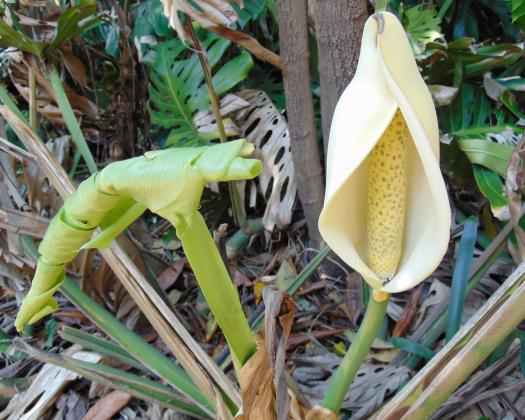Monstera deliciosa – Seedlings crawl away from light
Backyard Horticulture
Monstera deliciosa is often called split leaf philodendron even though it is not a Philodendron. The genera Monstera and Philodendron are both in the Araceae family with similar flowers. Both have a spadix, a spiked inflorescence with small flowers on a fleshy stem surrounded by a leaf-like curved bract or collar. Other names for the plant are ceriman, cerimon, Swiss cheese plant, fruit salad plant, piñanona and just monstera.
M. deliciosa is a large-leafed, vining plant with an unusual habit. In its native forests of Central America, in the shade of large trees, seedlings grow away from the light. This is called negative phototropism. The movement is described as crawling. It does this until it bumps into a tree trunk. Then, with tough aerial roots, it begins climbing toward the sunlight, reversing its negative phototropism. Aerial roots are used to make ropes and baskets.
In the wild, the vine can be more than 3 inches thick. Unsupported it spreads over the ground forming mats. When it climbs a tree, it can grow to more than 60 feet. Leaves are alternate, dark green, leathery and heart-shaped, 2 to 3 feet long. The older the plant gets the more slits and holes are formed. Some say this helps withstand heavy rains and winds of hurricanes in its native habitat. Others say holes allow more light to reach lower leaves. It’s possible that weight reduction of the large leaves is a factor. The plant is the subject of several studies.
Flowers are beige to white, but it doesn’t usually flower when grown indoors. Fruit, called the ceriman, resembles a pale ear of corn with hexagonal segments, scales. It ripens from the bottom and as it ripens, the segments at that point will fall away revealing the fruit. It is only at that point that the fruit is fragrant and edible. You must wait for other segments to fall before eating the fruit there.
Most in Grimes County have probably not tasted the “monstrous delicious” fruit of M. deliciosa. Its flavor has been described as like fruit salad, a combination of banana, pineapple and pear. It is a flavoring in foods and alcoholic beverages. It is considered a delicacy but is difficult to eat. Throughout are the stamen remains, long black fibers that must be removed. Until ripe, the fruit is full of a high concentration of oxalic acid that will irritate, possibly blister, your mouth and digestive tract. The fruit takes 12 to 14 months to ripen. There are often unopened inflorescences, immature and ripe fruits on the same plant. M. deliciosa is in the Food and Drug Administration Poisonous Plant Database at fda.gov.
Leaves and roots are used medicinally to treat arthritis, snakebites, flu, rheumatism, etc. The National Institutes of Health, ncbi.nlm.nih.gov, has information about the plant’s other medicinal uses along with some warnings. The title is “Medicinal Plants from North and Central America and the Caribbean Considered Toxic for Humans: The Other Side of the Coin.”
Deborah Richardson is a freelance reporter for The Examiner with a fondness for flora in its natural setting.


